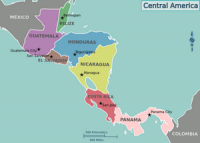-
Private prisons have a political role in corrections issues in the U.S.
Private prisons hold more than 120,000 inmates, about 8 percent of all prisoners, for 29 states and the federal government. The two largest private prison companies also operate more than 13,000 beds for immigrant detention. Private prisons play a political role in immigration and incarceration issues in the United States and the industry may face obstacles as well as opportunities in the current political landscape, new research finds.
-
-
Can Trump's threat of mass deportation of undocumented aliens be implemented?
On Monday, President Trump tweeted that Immigration and Customs Enforcement (ICE) “will begin the process of removing the millions of illegal aliens who have illicitly found their way into the United States” next week. Can this really happen? How soon? And what would that look like?
-
-
Is cutting Central American aid going to help stop the flow of migrants?
The United States is now stepping up its pressure on the governments of El Salvador, Guatemala and Honduras to take steps to curtail the migration of their own citizens by constricting U.S. aid. About $370 million in aid money for the three countries included in the 2018 budget will be spent on other projects, the State Department said on 17 June. Like many experts, I argue that slashing aid is counterproductive because foreign assistance can address the root causes of migration, such as violence and poverty.
-
-
Lawmakers raise alarm over CBP’s use of facial recognition tech on American citizens
Lawmakers last week sent a letter to acting DHS secretary, sounding the alarm over reports that U.S. Customs and Border Protection (CBP) is using facial recognition technology to scan American citizens — raising concerns over privacy and potential misuse of the American people’s biometric data.
-
-
Report: DHS agents heading to Guatemala
The United States is reportedly sending dozens of Department of Homeland (DHS) security agents and investigators to Guatemala to help stem the flow of unauthorized migration from Central America to the U.S. Anonymous U.S. officials with knowledge of the situation said DHS personnel will advise Guatemalan police and migration authorities on how to halt human smuggling.
-
-
Death threats and disease drive more Venezuelans to flee
There are currently some 3.7 million refugees and migrants from Venezuela worldwide, the vast majority in Latin America and the Caribbean. Given the worsening political, economic, human rights and humanitarian situation in Venezuela, the UN Refugee Agency, now considers that the majority of those fleeing the country are in need of international refugee protection.
-
-
Israelis rush to aid Venezuelan refugees in Colombia
Israeli NGO begins relief distributions in Colombia as thousands escape worsening conditions across the border daily.
-
-
The “smarter” wall: how drones, sensors, and AI are patrolling the border
In an era of increasingly polarized politics, there are few issues as divisive as President Trump’s proposal to build a physical wall across part of the 2,000-mile US-Mexico border. Shirin Ghaffary writes in Vox that there is another kind of border wall increasingly being talked about — one that proponents pitch as being less costly, less disruptive, and less politically controversial than a physical barrier: a so-called “smart wall.”
-
-
Administration’s immigration plan prioritizes skills, merit over family
President Donald Trump is scheduled to announce his long-awaited proposal on immigration Thursday, a plan that aims to move the immigration approval process away from family-ties and humanitarian needs. Administration official said the plan will bolster border security and create a merit-based system, insisting that it is a “competitiveness issue.”
-
-
New research on immigration, terrorism, and ideology
In the 43 years between 1975 and 2017, terrorists — foreign-born, native-born, and unknown – killed 3,518 Americans on U.S. soil (this includes the 9/11 attacks). During the same period, about 800,000 Americans were killed in homicides. Overall, the chance of being murdered by a foreign-born terrorist between 1975 and 2017 was about 1 in 3.8 million per year. The author of a new report says that the main lesson from the report is that there are very few terrorists of any ideology or origin who pose a threat to Americans on U.S. soil, and even fewer who manage to murder Americans. “The ideology, frequency, deadliness, and origins of terrorists are fascinating,” the author says, but these numbers are so small that it is difficult “to be overwhelmed by fear.”
-
-
Three new ways for Congress to legalize illegal immigrants
A critical element of any future immigration reform will be the legalization of illegal immigrants. Previous immigration reform proposals have failed, largely because policymakers disagreed over whether and how to legalize illegal immigrants. Alex Nowrasteh and David Bier write in a Cato Institute policy brief that future immigration reform proposals must be different from previous proposals if there is any hope of them becoming law. Past legalization reforms introduced by members of Congress were too similar to one another. They all failed. Our proposals provide three new means for legalizing illegal immigrants that will overcome some of the main political objections in the past: 1) Legalizing immigrants through a tiered system, whereby illegal immigrants can choose to either be legalized quickly and cheaply without the ability to gain citizenship in the future or begin a lengthier and expensive path toward citizenship; 2) Rolling legalization by allowing long-term illegal immigrant residents to legalize their status on an ongoing basis without an application cutoff date; and 3) Slowing chain immigration by limiting legalized immigrants’ ability to sponsor family members from overseas for lawful permanent residency (LPR) or green cards.
-
-
DHS’ assertion of broad authority to search travelers’ phones, laptops challenged
The Electronic Frontier Foundation (EFF) and the ACLU the other day asked a federal court to rule without trial that the Department of Homeland Security violates the First and Fourth Amendments by searching travelers’ smartphones and laptops at airports and other U.S. ports of entry without a warrant.
-
-
ICE looking at housing migrant children at Guantánamo Bay: Report

DHS is considering housing migrant children at the U.S. military prison at Guantanamo Bay to help deal with a sharp increase in the number of immigrants crossing the U.S. southern border. The idea was first proposed earlier this year as DHS looked for military facilities in which to hold undocumented immigrants as they wait for their cases to be processed. There are no immediate plans to bring children to Guantanamo Bay, and officials admit that the optics of housing children next to terrorists would be problematic.
-
-
Lucrative human smuggling business via Central America benefits many

A new report estimates that the smuggling of unlawful migrants from the Northern Triangle region of Central America—Guatemala, Honduras, and El Salvador—to the United States generated between $200 million and $2.3 billion for human smugglers in 2017.
-
-
African asylum-seekers may bear brunt of proposed travel curbs

As the White House mulls new travel restrictions on countries with high visa overstay rates, activists say African asylum-seekers may feel the consequences.
-
- All
- Regional
- Water
- Biometrics
- Borders/Immig
- Business
- Cybersecurity
- Detection
- Disasters
- Government
- Infrastructure
- International
- Public health
- Public Safety
- Communication interoperabillity
- Emergency services
- Emergency medical services
- Fire
- First response
- IEDs
- Law Enforcement
- Law Enforcement Technology
- Military technology
- Nonlethal weapons
- Nuclear weapons
- Personal protection equipment
- Police
- Notification /alert systems
- Situational awareness
- Weapons systems
- Sci-Tech
- Sector Reports
- Surveillance
- Transportation
Advertising & Marketing: advertise@newswirepubs.com
Editorial: editor@newswirepubs.com
General: info@newswirepubs.com
2010-2011 © News Wire Publications, LLC News Wire Publications, LLC
220 Old Country Road | Suite 200 | Mineola | New York | 11501
Permissions and Policies
Editorial: editor@newswirepubs.com
General: info@newswirepubs.com
2010-2011 © News Wire Publications, LLC News Wire Publications, LLC
220 Old Country Road | Suite 200 | Mineola | New York | 11501
Permissions and Policies
